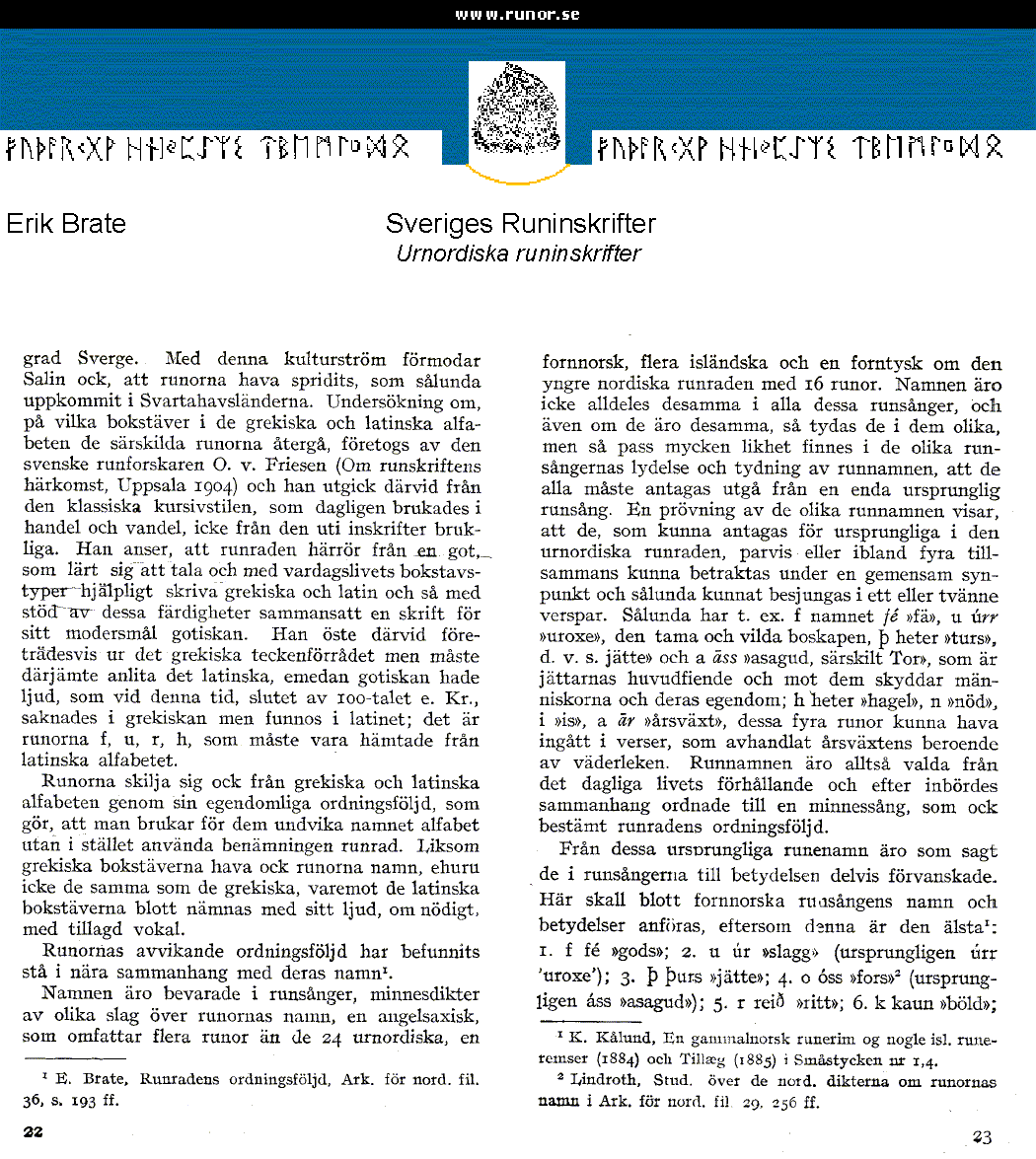
With this cultural stream B.
Salin suppose that the runes have been spread and that it has its
origin from Black Sea’s countries. Studies about which letters in the
Greek alphabet and the Latin alphabets that special runes originate
from was carried out by the Swedish runologist O. v. Friesen (“About
runic letters origin”, Uppsala 1904). He worked with the classic italic
style, which was daily used in treading and dealing and not with the
customary inscriptions. He thought that the runic alphabet originates
from one Goth, who learned to read and how to write Greek and Latin and
with that base of knowledge he composed letters in his mother tongue
language the Gothic. He used especially the letters from the Greek
language but also from the Latin language, as the Gothic had sounds
that were missing in the Greek language around 3rd century
AD.
The runes f, u, r, h must originate from the Latin alphabet.
The remarkable sequence of the
rune letters is different from Greek and Latin because of that you
should avoid the name alphabet and instead name it
rune row. Like the Greek letters the runes have names, although not the
same as in Greek, but the Latin letters only is mentioned for the sound
and if necessarily with added vowel. The runes remarkable sequence
depends on their names. (1). The names are preserved in rune songs,
memory poems of the names of the runes, one Anglo-Saxon that include
more than 24 runes as in Old Nordic, one
(1) Brate, Runradens sequence, Ark, för nord, fil.
36, s, 193 et seq. 22
Old Norwegian, several Icelandic
and one Old German about the younger Nordic rune
row with 16 runes. The names are
not the same in all these rune songs but
thus much similarity is found in these different rune
songs so the names are supposed to be from one original rune song. Analysis of
this rune names shows that this rune names that
supposed to be the original rune row of the Old Nordic, in pairs or sometimes
in four could be sung in one or two
verse pairs.
Thus the letter f has the name fe’ “fä (poultry)”, u “urr” “uroxe (old bullock)” the tame and wild cattle, þ is called “turs”, that means “giant” and a “äss” “asagud (Aesir)”, especially Thor who is the giants' enemy who protect the people and their property. h is called ”hagel (hail)”, n “nöd (need)”, i “is (ice)”, a “är” “årsväxt (vintage)”, these last four runes can have been included in verses, when they talked about how vintage is dependent on the weather. The rune names are select from names that describe the daily life and are arranged as a memory song and this determined the order of the rune row. The rune names have partly been distorted in the rune songs. The Norwegian rune names shall then be used since this is the oldest (1):
1. f fe’ “gods (goods)”;
2. u ur “slag (slag)” (originally urr “uroxe
(old bullock)”;
3. þ þurs” jätte (giant) ";
4. o oss “fors (rapids) (2)” ; (originally ass “asagud (Aesir)”;
5. r reið “ritt (riding tour)”;
6. k kaun “böld (boil) “;
Thus the letter f has the name fe’ “fä (poultry)”, u “urr” “uroxe (old bullock)” the tame and wild cattle, þ is called “turs”, that means “giant” and a “äss” “asagud (Aesir)”, especially Thor who is the giants' enemy who protect the people and their property. h is called ”hagel (hail)”, n “nöd (need)”, i “is (ice)”, a “är” “årsväxt (vintage)”, these last four runes can have been included in verses, when they talked about how vintage is dependent on the weather. The rune names are select from names that describe the daily life and are arranged as a memory song and this determined the order of the rune row. The rune names have partly been distorted in the rune songs. The Norwegian rune names shall then be used since this is the oldest (1):
1. f fe’ “gods (goods)”;
2. u ur “slag (slag)” (originally urr “uroxe
(old bullock)”;
3. þ þurs” jätte (giant) ";
4. o oss “fors (rapids) (2)” ; (originally ass “asagud (Aesir)”;
5. r reið “ritt (riding tour)”;
6. k kaun “böld (boil) “;
(1) K. Kålund, En gamlnalnorsli runerim og nogle isl, runeremser
(1884) och (1885) i Småstycken nr 1,4.
(2) Lindroth, Stud. över de nord, dikterna om runornas namn i Ark, för
nord. fil. 29, 256 ff.